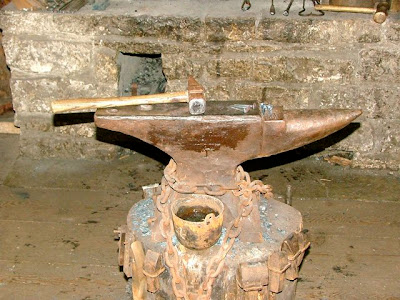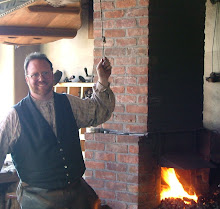Our oldest anvil is probably much like one that Mr. Peleg Field would have seen and used during his apprenticeship in the 1780’s. It is an English pattern “5th foot” anvil. That nickname comes from that fact that it has 5 feet, not 4! Chunky and squat, this style of anvil was made by teams of trained smiths working to forge the anvil from up to 11 pieces of wrought iron and then forge welding a steel plate onto the face. While often only around 120lbs, this would have been a blacksmith shop primary anvil in the 19th century. This style with the 5th foot harkens back to features found on anvils in the 17th and even 16th centuries.
This Vulcan Works anvil from Sheffield is a transitional anvil (below). Probably made in the late 18th or first third of the 19th century, it bridges the gap between the small and squat older style and the larger and longer London or American Pattern. This anvil still has the small horn of the earlier style but also has the thinner heel of the London Pattern.
The Peter Wright anvil below was made in London, England in the mid-19th century. It is the shape that most people recognize in the United States as a modern anvil. It is around 155lbs. The larger horn and long thin heel of the anvil face makes this a versatile tool. This is the anvil we use at the front forge in the Field Blacksmith shop.
At the back forge is a larger anvil made in the same style as the Peter Wright at the front forge. Larger than the previous anvil, it is around 180lbs. You can feel the benefit of that extra mass when using it. It provides a very solid surface for larger work like hinges and wagon parts.
Anvils were such common tools in daily life and last such a long time, that there is a surprising amount of diversity among old anvils. Unlike other items that are 150 to 300 years old, anvils are generally considered tools rather than antiques. With good care, these anvils will be in use as we work and demonstrate to the public for decades to come.






Love your Blog! I found it through The Rasch Outdoor Chronicles™! I’ll be checkin out your archives! I specialize in “Best Of” posts, and your blog will be added to one of my posts.
ReplyDeleteRock on Dude!
Storme
Best Android Apps
Best Blackberry App: Twitter!
Neat blog; wish I'd found it sooner. Now I've got some catching up to do!
ReplyDeleteWho would have ever thought that pictures of anvils could be interesting?
ReplyDeleteGood.
Grace and peace
I'm looking into buying an anvil for the first time what do you think i should look for!?i found and posted a site on my blog with a website that had some if you can do you think you could check the site and tell me if its a good deal??
ReplyDeletethank you for your time!!!
I've been a ferrier for some years and in my truck carry a Peter Wright Patent England
ReplyDelete# 1 0 15 (155lb?) horses have to be to the truck. Am going out of business and was wondering what a fair price would be. It's good shape with maybe 3 chips on the edge of face. Live in N.E. Tennessee. 423/727/9891
Thanks for the pictures.. Interesting. Steve
Have the Peter Wright anvil as in your 2nd photo. The flat edge (not horn side) is chipped.
ReplyDeleteDo you have any idea what it would be worth? Trying to sell off my Dad's tools since he passed away.
Please email me at lesandsara@gmail.com
To clarify...the 2nd anvil photo.
ReplyDeleteThanks
Nice blog;
ReplyDeleteI have an anvil,very old and looks just like your blog picture as the last one with a hammer on top. Mine is marked 304# and can't quite make out the name,looks like "Cole or Coel.Would you give me an idea of it's value? Brianziehl@msn.com Thanks so much-I could also send a pic if needed...
i have an old lead filled anvil would love to fine out something about it. Con text or email a picture if needed.
ReplyDeleteYou state and show an anvil:
ReplyDeleteThe Peter Wright anvil below was made in London, England in the mid-19th century.
Peter Wright was Uncle to my Great Grandmother. As far as I know ALL his anvil's were made in Dudley, England.
I'm curious. I'm not able to get a close up of what is marked. Any info about this would be helpful.
FYI:
1900 - Dudley works; “Solid Wrought” dropped from anvil logo.
1914 - Wright business at Dudley & Edgbaston; Company buy out: bought by Boulton’s of Stourbridge
New company continued to produce anvils under Peter Wright name.
Thank you.
Sorry. I forgot to say...Not made in London. Believe you meant to say : London Pattern.
ReplyDeleteI recently came across an old non horn anvil that is rather large and I am trying to find some information on.It weighs 380 lbs. On one end of it it has what looks like a shield and in this shield looking thing it has NSG9 stamped into it and on the other end, it has the same stamped in. Does anyone out there know who the manufacture of this anvil is? Please let me know if you do. Thanks
ReplyDelete